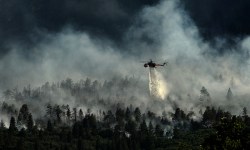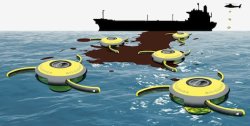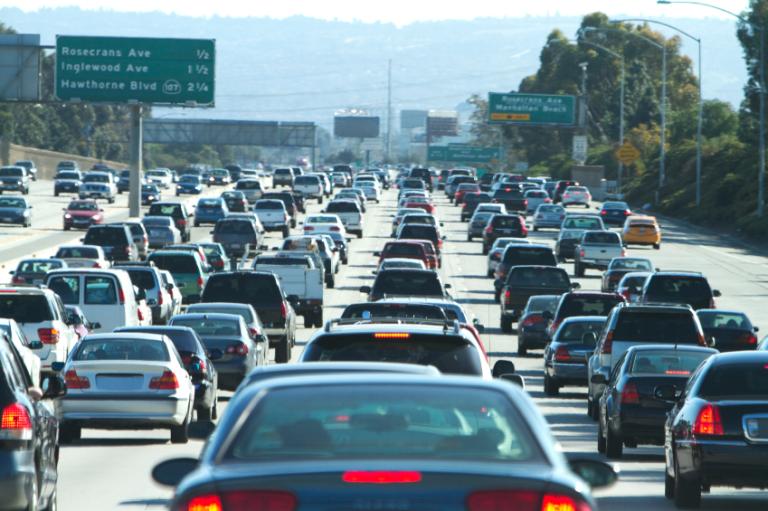A version of this article originally appeared on Climate Progress.

Someday soon, robots could help us fight wildfires like the ones blazing in Colorado. (Photo by U.S. Air Force.)
In the last few years, we’ve seen an increase in extreme weather events and environmental disasters — costing us money, and far more importantly, human lives.
Some have been natural (or indirectly caused by humans due to climate change), and others, like BP’s Deepwater Horizon oil spill in the Gulf of Mexico, have been directly caused by us.
With scientists warning that the frequency of wildfires, floods, drought, and other catastrophes will only increase as the planet warms, engineers are now focusing on how to use robots and other mechanical gadgets to aid in disaster response. Some of these bots vacuum up oil, some sort rubble and rescue earthquake survivors, and some help battle wildfires. Here’s a look at three of the coolest robotic defenders, both in use and on the horizon.

Image by John MacNeill.
Firebug: Right now in Colorado, the Waldo Canyon Wildfire is burning out of control. As of Thursday, 30,000 people had been evacuated and firefighters had only 5 percent of the blaze contained.
Enter the firefighting robot army. Three groups — one at University of Magdeburg-Stendal in Germany, an American duo, and the makers of the Segway — are all working on a revolutionary and potentially life-saving technology.
The German group has plans for an insect-inspired bot called the OLE. The Saint-Bernard sized bugs are covered in fireproof armor and carry sensors that help them find fires. Once they get to the heat source, they can spray it with water or other fire-extinguishing materials. The bots have legs instead of wheels, helping them to navigate over downed trees, rocks, and other forest impediments that rolling machines would have trouble with, and letting them get to fires faster. (Interestingly, these OLEs look kind of like pine beetles, the ferocious bugs wreaking havoc on western forests.)
Marching into battle alongside the OLEs (and possibly a lot sooner) could be Segway’s design. Armed with a water cannon that can launch up to 10 gallons per second and Segway’s motors that let it travel up to 18 miles per hour, this robot is the heavy artillery of robo wildfire-fighting. Though it’s fast, its wheels make it less maneuverable than the OLE; however, this bot has the ability to haul injured or exhausted human firefighters out of harm’s way.
Behind the OLE and the Segway bot, a transformer-like robot could be clearing trees at a frenzied pace, creating the firebreaks that are so vital to containing a blaze. Though the robot looks like something out of science fiction, its creators have already built a prototype. The robot uses its four arms and massive cutting blades to completely deforest an area rapidly. Clearly, these bots could be dangerous for forests if used the wrong way. But in emergency scenarios they could help save thousands of lives and homes.

Image by Hsu Sean.
Splashdown: The Obama administration is in favor of offshore drilling for oil in the Arctic, despite the fact that there is no infrastructure in place to deal with an oil spill if one occurred.
Clearly, not drilling in such a sensitive place is preferred. But that doesn’t mean we should stop thinking about how to address a mess if companies do start operating there.
Designer Hsu Sean has envisioned a unique design that eliminates the need to use big, expensive, complex machinery to put chemical dispersants into the water. Sean’s design uses oil-degrading bacteria housed inside of a robot-vacuum vessel to treat oil spills without releasing nasty chemicals that secondarily pollute the water. The devices also contain a sonic emitter that drives marine wildlife away, helping to steer them clear of the oil slick.
The best part is that the devices can be deployed via helicopter and simply dropped into the ocean, thereby limiting the need for a response fleet and the necessary support infrastructure.
Search and rescue: Unlike fire and oil spills, many disasters can’t be dealt with until they are over. For disaster response to things like earthquakes, hurricanes, and tornadoes, the most important thing is finding and rescuing survivors in piles of unstable, toxic, or even radioactive rubble. There is no shortage of robots ready to help out:
- This snake-like bot can wriggle into the tiniest crevasses to find buried survivors.
- This one eats people.
- This one opens doors.
- This cockroach-sized robot can detect when piles of rubble might collapse.
- And here’s one powered by your Xbox.
There’s no substitute for good planning to prevent disasters — whether it be in how we build our communities or take actions to mitigate climate change. But we still need innovations like this to help us out when we inevitably face a catastrophe.




